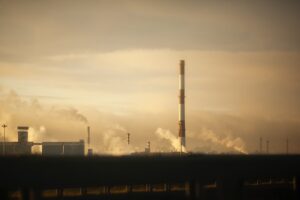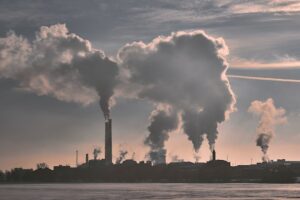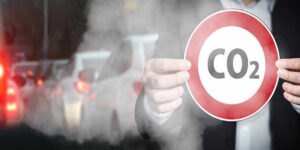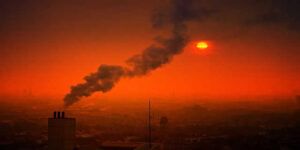In this article we will briefly discuss 10 Industries That Contribute The Most To Air Pollution. According to the Environmental Protection Agency, the 6 most common air pollutants that need to be addressed in order to reduce air pollution are:
- Carbon monoxide (CO)
- Lead (Pb)
- Sulfur dioxide (SO2)
- Nitrogen dioxide (NO2)
- Ground level ozone (O3)
- Particular matter (PM)
These pollutants are released during many activities, both domestic and industrial. In this article the most pollutant industries regarding air pollution will be addressed and described.
1. Manufacturing
the manufacturing industry was and is one of the two largest contributors to air pollution. In this industry, several processes take place: energy consumption, heating, transportation, toxic wastes treatment, among others. Some of the most common air pollutants generated by the manufacturing industry include volatile organic compounds (VOCs), hazardous air pollutants (HAPs) and solid particulate matter (PM).
2. Construction
According to a study presented by the UK Green Building Council the construction contributes to around 23 percent of air pollution. In addition to this, all the people exposed to the dust from the construction sites are in high risk of developing severe health and lung issues. This accounts not only for the people who work in the construction, but also for those who live in close areas or neighborhoods. Contaminants in the air can travel long distances in a short time.
The main construction contaminants that can spread around by wind are:
- Particulate matter (PM)
- Volatile organic compounds (VOCs)
- Carbon monoxide (CO)
- Nitrogen oxides (NOx).
3. Transportation
Transportation is one of the most contributing industries to air pollution. Due to the combustion that takes place in the motors during its functioning, many pollutants are released to the atmosphere.
Both on-road (trucks, cars, etc.) and nonroad transports (plane, ships, etc.) release air pollutants like smog, ozone and carbon monoxide to the atmosphere. This is particularly dangerous for people living in the surroundings of busy roads.
In 2013, transportation accounted for more than half of the carbon monoxide and nitrogen oxides emitted into our air.
4. Chemical
Chemical industry is one of the most powerful industries contributing to environmental pollution. All the chemical manufacturing processes uses natural resources, so the contamination not only occurs within the factory but in the nature where the raw materials are extracted.
Air emissions coming from chemical manufacturing contain harmful substances which might have negative effects both on the environment and human health.
These substances can be, among others:
- Nitrous oxides (NOx)
- Particular matter (PM)
- Sulphur dioxide (SO2)
- Volatile organic compounds (VOCs)
This Emissions to air can be a result from:
- Reaction or distillation facilities
- Combustion plants
- Products used in specific chemical processes
- Storing raw materials such as solvents
- Waste and wastewater treatment processes
5. Agriculture
Air pollution from agriculture comes mainly in the form of ammonia. This chemical is released due to the use of heavily fertilized fields and livestock waste. The ammonia combines in the air with pollutants from combustion, mainly NOx and sulfates from vehicles, power plants and industrial processes. This creates tiny solid particles (PM2.5), that can penetrate deep into lungs, causing heart or pulmonary disease. According to a 2015 study in the journal Nature these emissions cause at least 3.3 million deaths each year globally.
A study presented in the Advancing earth and space science magazine in 2016, says that there are 3 regions where agriculture is a significance source of air pollution: Europe, the eastern U.S. and China. In these areas, emissions from farms outweigh all other human sources of fine-particulate air pollution. However, the conclusion of this study was that if other industrial emissions decline in coming decades, fine-particle pollution will go down so agriculture will be able to continue as it is without any additional harm to the environment.
6. Electricity
When it is used, electricity is a clean and relatively safe form of energy. However, the generation and transmission of electricity affects the environment. Most electric power plants have a negative effect on the environment, some power plants having larger effects than others.
In the US, 65% of total electricity generation in 2018 was obtained via fossil fuels (coal, natural gas, and petroleum), biomass and wastes. When the combustion takes place, the following pollutants are released to the atmosphere:
- Carbon dioxide (CO2)
- Carbon monoxide (CO)
- Sulfur dioxide (SO2)
- Nitrogen oxides (NOx)
- Particulate matter (PM)
- Heavy metals such as mercury
According to a research presented by the University of Washington, air pollution from electricity industry emissions led to16,000 premature deaths in the US in 2014. According to researchers, 91% of premature deaths were the result of emissions from electricity plants powered by coal.
7. Oil & gas
A variety of air contaminants are emitted throughout the oil and gas extraction, production and processing. Some of the stages where these compounds are released are mentioned below:
- Condensate tanks
These tanks stock liquid hidrocarbons as well as aromatic hidrocarbons (benzene, toluene, xylenes and ethylbenzene). Above 150 ppm people can experience serious and irreversible health effects.
- Construction activity
The oil & gas extraction requires construction to be made previous the extraction begins. This stage not only disturbes the soils with the machinery but also generate generate particulate matter and stir up dust, which in turn react with the other prerequisites to form ground-level ozone, or smog.
- Fugitive emissions
These include unintentional leaks of gases due to breaks or cracks in the equipment or tubes or seals. If natural gas escapes via fugitive emissions, methane will be released to the atmosphere as well as VOCs and other contaminants.
8. Waste management
Waste management can emit toxic and pollutant substances whether if the waste is incinerated or disposed in a municipal or industrial facility.
- Incineration:
In incineration facilities, the following pollutants are released:
- Dioxin (a well-known carcinogen)
- Carbon monoxide (CO)
- Nitrogen oxides (NOx)
- Mercury
- Lead
- Sulfure oxides (SOx)
However, in a study published in 2019 it is stated that in developed countries and regulated facilities that comply with the legislation on emissions, controlled incineration shouldn’t have any cancer or development risks.
- Municipal/Industrial facility
Studies have acknowledged the presence of VOCs and other gaseous pollutants such as methane, ammonia, and hydrogen sulphide in air surrounding the waste treatment and disposal facilities.
There were cases where the levels exceeded the maximum concentration limits of air quality standards. Adverse environmental impact of air pollutants is a major concern in the industrial more than in the municipal waste treatment but they both pose a risk to the public health when sitting in urban areas.
9. Metallurgical
In the metallurgical industry, the following pollutants are released during the different stages:
- Sulfure oxides (SOx)
- Particulate matter (PM)
- Nitrgen oxides (NOx)
According to a 2016 study, the iron and steel industry has contributed 11,15%, 8,83% and 28,98% to Chinese anthropogenic emissions of sulfur dioxide (SO2), nitrous oxides (NOx) and particulate matter (PM) in 2015.
10. Paint & Coating
According to the EPA, Paint and Coating manufacturing facilities emit pollutants such as :
- Hazardous air pollutants (HAPs)
- Volatile organic compounds (VOC)
- Particle pollution (dust)
At the same time, dangerous releases of HAPs can occur if a paint and coating manufacturing facility does not operate in compliance with regulations.
- Mixing and cleaning operations might release HAPs and VOC. The chemicals contained in these substances can react in the air, leading to ozone (smog, which has been linked to many respiratory effects and diseases.
- Pigment grinding and milling can lead to emission of particle pollution (dust), which can contain not only heavy metals but also other HAPs.
10 Industries That Contribute The Most To Air Pollution.
References
Air pollutants according to WHO:
https://www.epa.gov/criteria-air-pollutants
Main sources of air pollutants:
https://www.conserve-energy-future.com/causes-effects-of-industrial-pollution.php
https://www.pnas.org/content/116/40/19768
http://www.eolss.net/sample-chapters/c09/e4-11-02-01.pdf
Transportation:
Manufacturing
Construction
https://www.environmentalpollutioncenters.org/construction/
Chemical
http://www.eolss.net/sample-Chapters/C09/E4-14-04-02.pdf
Agricultural
https://www.nature.com/articles/nature15371
Electricity
https://www.eia.gov/energyexplained/electricity/electricity-and-the-environment.php
Oil & gas
Waste
https://www.clf.org/blog/whats-wrong-with-burning-our-trash-anyway/
https://www.tandfonline.com/doi/abs/10.1080/10934520500298895
Metallurgical
https://www.sciencedirect.com/science/article/abs/pii/S1352231020304003
Pains & coating
Image by analogicus from Pixabay





